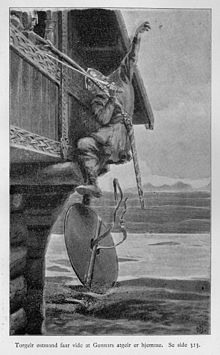
A polearm or pole weapon is a close combat weapon in which the main fighting part of the weapon is fitted to the end of a long shaft, typically of wood, extending the user's effective range and striking power. Polearms are predominantly melee weapons, with a subclass of spear-like designs fit for thrusting and/or throwing. Because many polearms were adapted from agricultural implements or other fairly abundant tools, and contained relatively little metal, they were cheap to make and readily available. When belligerents in warfare had a poorer class who could not pay for dedicated military weapons, they would often appropriate tools as cheap weapons. The cost of training was comparatively low, since these conscripted farmers had spent most of their lives using these "weapons" in the fields. This made polearms the favoured weapon of peasant levies and peasant rebellions the world over.

The sagas of Icelanders, also known as family sagas are a subgenre, or text groups of Icelandic sagas. They are prose narratives mostly based on historical events that mostly took place in Iceland in the ninth, tenth, and early eleventh centuries, during the so-called Saga Age. They were written in Old Icelandic, a western dialect of Old Norse. They are the best-known specimens of Icelandic literature.
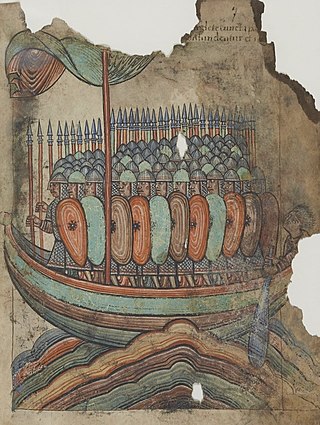
Vikings were seafaring people originally from Scandinavia, who from the late 8th to the late 11th centuries raided, pirated, traded, and settled throughout parts of Europe. They also voyaged as far as the Mediterranean, North Africa, the Middle East, Greenland, and Vinland. In their countries of origin, and some of the countries they raided and settled in, this period is popularly known as the Viking Age, and the term "Viking" also commonly includes the inhabitants of the Scandinavian homelands as a whole. The Vikings had a profound impact on the early medieval history of Scandinavia, the British Isles, France, Estonia, and Kievan Rus'.

Gunnar Hámundarson was a 10th-century Icelandic chieftain. He lived in Hlíðarendi in Fljótshlíð and is probably better known as Gunnar of Hlíðarendi. He features prominently in the first half of Njáls saga, which tells of the chain of events ultimately leading to his death in battle.

The Norsemen were a North Germanic linguistic group of the Early Middle Ages, during which they spoke the Old Norse language. The language belongs to the North Germanic branch of the Indo-European languages and is the predecessor of the modern Germanic languages of Scandinavia. During the late eighth century, Scandinavians embarked on a large-scale expansion in all directions, giving rise to the Viking Age. In English-language scholarship since the 19th century, Norse seafaring traders, settlers and warriors have commonly been referred to as Vikings. Historians of Anglo-Saxon England distinguish between Norse Vikings (Norsemen) from Norway, who mainly invaded and occupied the islands north and north-west of Britain, as well as Ireland and western Britain, and Danish Vikings, who principally invaded and occupied eastern Britain.

In the Old Norse written corpus, berserkers were those who were said to have fought in a trance-like fury, a characteristic which later gave rise to the modern English word berserk. Berserkers are attested to in numerous Old Norse sources.
Sagas are prose stories and histories, composed in Iceland and to a lesser extent elsewhere in Scandinavia.

Old Norse religion, also known as Norse paganism, is a branch of Germanic religion which developed during the Proto-Norse period, when the North Germanic peoples separated into a distinct branch of the Germanic peoples. It was replaced by Christianity and forgotten during the Christianisation of Scandinavia. Scholars reconstruct aspects of North Germanic Religion by historical linguistics, archaeology, toponymy, and records left by North Germanic peoples, such as runic inscriptions in the Younger Futhark, a distinctly North Germanic extension of the runic alphabet. Numerous Old Norse works dated to the 13th-century record Norse mythology, a component of North Germanic religion.

A shield-maiden was a female warrior from Scandinavian folklore and mythology.

The Dane axe or long axe is a type of European early medieval period two-handed battle axe with a very long shaft, around 0.9–1.2 metres at the low end to 1.5–1.7 metres or more at the long end. Sometimes called a broadaxe, the blade was broad and thin, intended to give a long powerful cut when swung, effective against cavalry, shields and unarmored opponents.
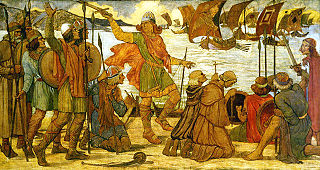
Knowledge about military technology of the Viking Age is based on relatively sparse archaeological finds, pictorial representations, and to some extent on the accounts in the Norse sagas and laws recorded in the 12th–14th century.

The Viking revival was a movement reflecting new interest in, and appreciation for Viking medieval history and culture. Interest was reawakened in the late 18th and 19th centuries, often with added heroic overtones typical of that Romantic era.
The hird, in Scandinavian history, was originally an informal retinue of personal armed companions, hirdmen or housecarls. Over time, it came to mean not only the nucleus ('Guards') of the royal army but also a more formal royal court household.
Old Norse literature refers to the vernacular literature of the Scandinavian peoples up to c. 1350. It chiefly consists of Icelandic writings.
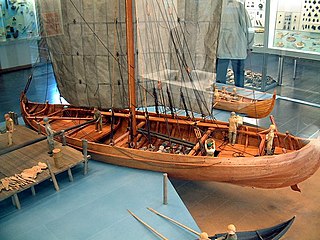
A knarr is a type of Norse merchant ship used by the Vikings for long sea voyages and during the Viking expansion. The knarr was a cargo ship; the hull was wider, deeper and shorter than a longship, and could take more cargo and be operated by smaller crews. It was primarily used to transport trading goods like walrus ivory, wool, timber, wheat, furs and pelts, armour, slaves, honey, and weapons. It was also used to supply food, drink, weapons and armour to warriors and traders along their journeys across the Baltic, the Mediterranean and other seas. Knarrs routinely crossed the North Atlantic carrying livestock such as sheep and horses, and stores to Norse settlements in Iceland, Greenland and Vinland as well as trading goods to trading posts in the British Isles, Continental Europe and possibly the Middle East. The knarr was constructed using the same clinker-built method as longships, karves, and faerings.

A swordstaff is a Scandinavian polearm, used in the Middle Ages. It is made by placing a blade at the end of a staff.

The spear or lance, together with the bow, the sword, the seax and the shield, was the main equipment of the Germanic warriors during the Migration Period and the Early Middle Ages.
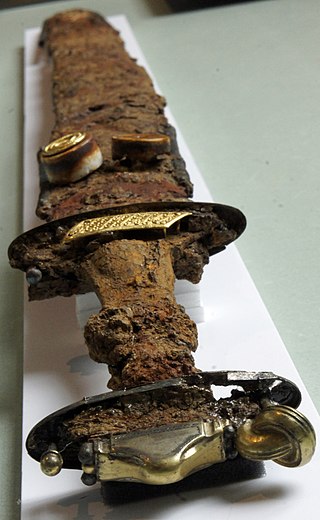
The Migration Period sword was a type of sword popular during the Migration Period and the Merovingian period of European history, particularly among the Germanic peoples. It later gave rise to the Carolingian or Viking sword type of the 8th to 11th centuries AD.
The Norrœna Society was an early 20th-century publishing house dedicated to Northern European culture. It published expensively produced reprints of classic 19th-century editions, mostly translations, of Old Norse literary and historical works, Northern European folklore, and medieval literature.
The term "halberd" has been used to translate several Old Norse words relating to polearms in the context of Viking Age arms and armour, and in scientific literature about the Viking Age. In referring to the Viking Age weapon, the term "halberd" is not to be taken as referring to the classical Swiss halberd of the 15th century, but rather in its literal sense of "axe-on-a-pole", describing a weapon of the more general glaive type.
